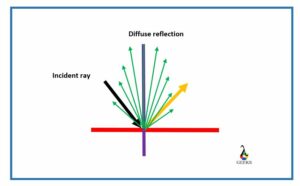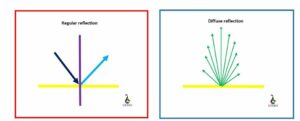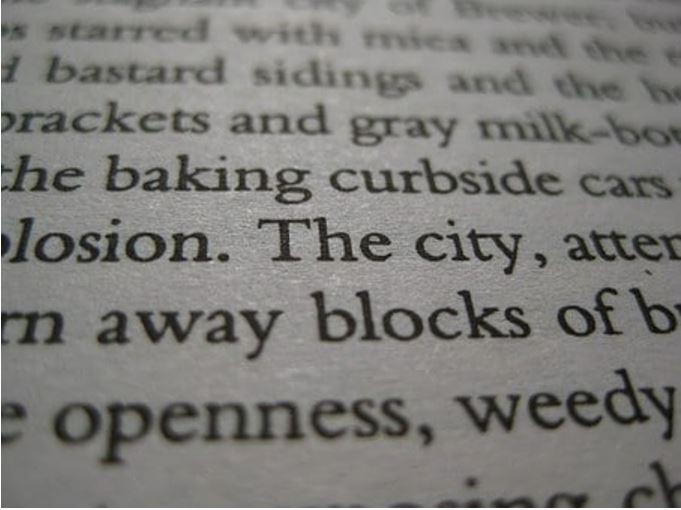In this post on physics, we will study the detailed insights and facts of what is diffuse reflection of radiation and other features.
The term reflection refers to the incident angle getting reflected at any point. Still, in the case of diffuse reflection, the incident ray of light gets reflected at many points with different angle measurements. It consists of a mixture of reflected rays produced from a single incident ray.
Before knowing the detailed facts of what is diffuse reflection of light let us first concentrate on the meaning of diffuse reflection.
Diffuse reflection of radiation: Concept and insights
The term diffuse refers to the fusion and reflection of radiation, indicating that the electromagnetic wavefronts are reflected from the point of the incident ray.
- The diffuse reflection of radiation in total signifies that the ray of light is reflected into several other angles in the same medium when a source of incident ray strikes the rough surface.
- The surface on which the radiation waves get reflected will not depend on the angle of the incident ray, and it is known as diffuse surface, and the reason for diverging rays is non-parallel rays and the rough surface.
Examples of diffuse reflection of radiation are a reflection from rough streets, textbook reading, bicycle reflectors.

What is a diffuse reflection of radiation?
Diffuse reflection of radiation is an important physical phenomenon.
It is an essential reflection of light rays produced from the rough surface. The incident ray strikes the uneven dots and scatters into many reflected rays that can observe at different angles in the same medium.
Now let’s focus on the difference between the regular and diffused radiation reflection.
Mention the primary differences between regular reflection and diffuse reflection
The essential fundamental differences between the regular and diffuse reflection of radiation are as follows,
| Parameters to define | Regular/ Specular Reflection | Irregular/Diffused reflection |
| Nature of Surface | Soft or smooth surface | A hard or rough surface |
| Angle of reflection | Parallel single reflection light | Reflection at different angles |
| Nature of reflection | Clear images | Blur reflective images |
| Examples | Sun, microscopes, telescopes, and bulb | Camera |

It’s time to know the cause for what is diffuse reflection of radiation.
What is the leading cause for diffuse reflection to occur?
The primary and vital cause for any diffused radiation reflection is the presence of uneven surfaces.
Almost all the material we use in daily life contains some minor irregular imperfections on the surfaces; when a beam of parallel rays focuses on these uneven surfaces, the light travels back in many other directions, which helps produce reflective images.
Therefore, these reflected rays at different angles combine to produce the required reflective image.
Examples of diffuse reflection of radiation
The crucial examples of what is a diffuse reflection of radiation in our daily life are mentioned below,
Reading a newspaper or book
The primary example of what is a diffuse reflection of radiation is reading a newspaper or any book. As we start to read text, its images are seen on the retina of our eyes, and at the same time, the light gets reflected from us; here, both the rays diffuse and help in reading by not producing our image on the book.

Driving on a wet road
When driving a car at night, and if the road is wet due to heavy rain, it becomes difficult to see the clear road. It happens because the light gets reflected the surface of the road into many different angles forming a blur reflective image that will be not visible to the driver making him drive in difficulty.

Reflection from clothing
When a light ray falls on a cloth, the reflection produced from it will not be clear because the surface of the cloth contains some irregular or uneven surface that makes the light reflect at many angles, making the image diffuse. It is a primary example of what is a diffuse reflection of radiation.

Reflection from paper
The surface of any paper will be somewhat rough and possess a higher degree of diffusion of light. If any ray of light falls on the paper, it will be filtered by some irregularities and diverges from many directions making the image unclear.

So, the above examples of what is diffuse reflection of radiation are essential to be known in real-life.
How can diffused reflection be useful for us in real life?
The diffuse reflection of radiation can be constructive in human life, without which most probably we couldn’t have the ability to see things.
- The essential aspects of diffused reflection of radiation are,
- Without the help of diffused reflection phenomenon, there would be no use of mirrors and cameras (help us to capture beautiful moments).
- It is every creature’s primary and essential ability that helps us see our beautiful surroundings.
- Apart from light tubes and the sun, all the things we can see are because of the diffused radiation reflection.
So, these are the paramount importance of what is a diffuse reflection of radiation.
To study about spherical mirror and components, click below
Frequently asked questions on diffused reflection of radiation | FAQs
What do you mean by reflection?
The primary example where we observe reflection is a mirror.
It is an essential physical phenomenon without which we could not see the images of one other. It is a phenomenon in which the incident wavefront of light strikes at a point, changes its direction at a certain angle, and comes back to the same media from which it is made to strike the interface of the medium.
What are the different types of reflection in physics?
There are mainly three essential types of reflection processes we study in physics. They are,
- Specular reflection or regular reflection process
- Diffused reflection or irregular reflection process
- Multiple reflection process
Is irregular and diffused reflection the same?
Irregular diffusion is the other term used to refer to diffused reflection.
In general, diffused reflection occurs on a rough or hard surface. It is a physical phenomenon that occurs when parallel- light rays pass and hit a point and reflect into the same medium in many other directions. It sometimes produces blurry images.
Can we say that diffuse reflection refers to the failure of laws of reflection?
Diffused radiation reflection does not refer to the failure of laws of reflection.
We know that diffused radiation reflection is also referred to as irregular reflection. The main feature of this diffused reflection is that it gets reflected from the rough surface and contains irregularities. However, the incident light gets reflected when it strikes at a particular point. So, it won’t violate the laws of reflection in almost all cases except some.
Why does the diffuse reflection phenomenon fail to produce the reflective images?
The diffuse reflection of the radiation phenomenon produces reflective images of low quality that can signify the failure to produce reflective images.
The uneven surface that makes the parallel beam of light reflected in many other directions reduces the quality of reflective images that makes it appear to blur. We can indicate that diffuse reflection fails to produce proper reflective images from this fact.
How can you differ from diffuse reflection from specular reflection?
The main difference between the two essential types of reflection lies in the surface from which it is produced.
Both regular (Specular) and irregular(diffused) radiation reflections reflect two different surfaces. First, the surface must be soft with no uneven dots for a specular reflection to occur. For a diffuse reflection to occur, the surface must contain uneven dots that make the incident light travel into other directions.
Also Read:

I am Raghavi Acharya, I have completed my post-graduation in physics with a specialization in the field of condensed matter physics. I have always considered Physics to be a captivating area of study and I enjoy exploring the various fields of this subject. In my free time, I engage myself in digital art. My articles are aimed towards delivering the concepts of physics in a very simplified manner to the readers.